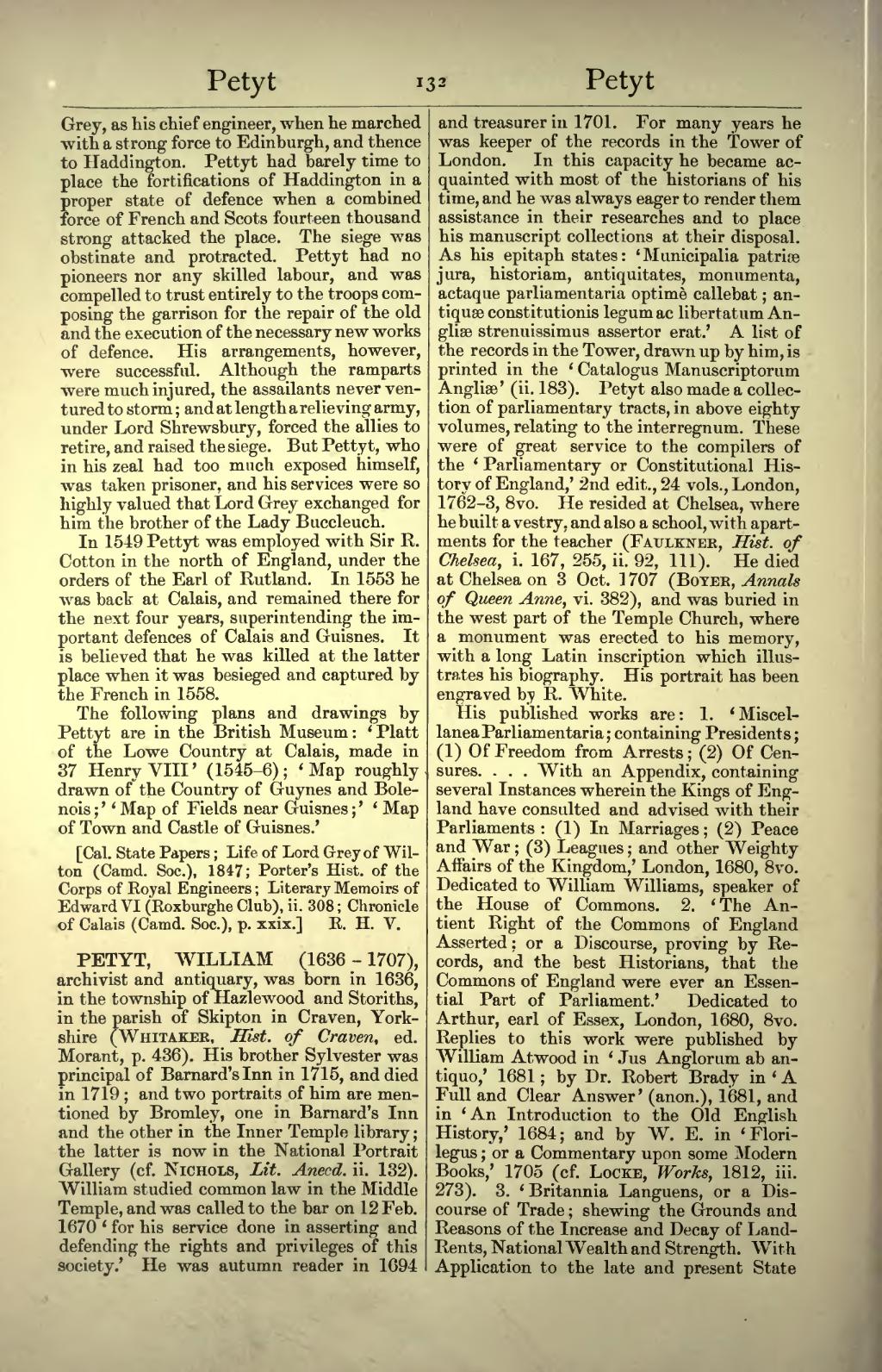Grey, as his chief engineer, when he marched with a strong force to Edinburgh, and thence to Haddington. Pettyt had barely time to place the fortifications of Haddington in a proper state of defence when a combined force of French and Scots fourteen thousand strong attacked the place. The siege was obstinate and protracted. Pettyt had no pioneers nor any skilled labour, and was compelled to trust entirely to the troops composing the garrison for the repair of the old and the execution of the necessary new works of defence. His arrangements, however, were successful. Although the ramparts were much injured, the assailants never ventured to storm; and at length a relieving army, under Lord Shrewsbury, forced the allies to retire, and raised the siege. But Pettyt, who in his zeal had too much exposed himself, was taken prisoner, and his services were so highly valued that Lord Grey exchanged for him the brother of the Lady Buccleuch.
In 1549 Pettyt was employed with Sir R. Cotton in the north of England, under the orders of the Earl of Rutland. In 1553 he was back at Calais, and remained there for the next four years, superintending the important defences of Calais and Guisnes. He was apparently killed at Guisnes when captured by the French in 1558.
The following plans and drawings by Pettyt are in the British Museum: ‘Platt of the Lowe Country at Calais, made in 37 Henry VIII’ (1545–6); ‘Map roughly drawn of the Country of Guynes and Bolenois;’ ‘Map of Fields near Guisnes;’ ‘Map of Town and Castle of Guisnes.’
[Cal. State Papers; Life of Lord Grey of Wilton (Camd. Soc.), 1847; Porter's Hist. of the Corps of Royal Engineers; Literary Memoirs of Edward VI (Roxburghe Club), ii. 308; Chronicle of Calais (Camd. Soc.), p. xxix.]
PETYT, WILLIAM (1641?–1707), archivist and antiquary, was born about 1641, in the township of Hazlewood and Storiths, in the parish of Skipton in Craven, Yorkshire (Whitaker, Hist. of Craven, ed. Morant, p. 436). His brother Sylvester was principal of Barnard's Inn in 1715, and died in 1719; and two portraits of him are mentioned by Bromley, one in Barnard's Inn and the other in the National Portrait Gallery (cf. Nichols, Lit. Anecd. ii. 132). William studied common law in the Middle Temple, and was called to the bar on 12 Feb. 1670 ‘for his service done in asserting and defending the rights and privileges of this society.’ He was autumn reader in 1694 and treasurer in 1701. For many years he was keeper of the records in the Tower of London. In this capacity he became acquainted with most of the historians of his time, and he was always eager to render them assistance in their researches and to place his manuscript collections at their disposal. As his epitaph states: ‘Municipalia patriæ jura, historiam, antiquitates, monumenta, actaque parliamentaria optimè callebat; antiquæ constitutionis legum ac libertatum Angliæ strenuissimus assertor erat.’ A list of the records in the Tower, drawn up by him, is printed in the ‘Catalogus Manuscriptorum Angliæ’ (ii. 183). Petyt also made a collection of parliamentary tracts, in above eighty volumes, relating to the interregnum. These were of great service to the compilers of the ‘Parliamentary or Constitutional History of England,’ 2nd edit., 24 vols., London, 1762–3, 8vo. He resided at Chelsea, where he built a vestry, and also a school, with apartments for the teacher (Faulkner, Hist. of Chelsea, i. 167, 255, ii. 92, 111). He died at Chelsea on 3 Oct. 1707 (Boyer, Annals of Queen Anne, vi. 382), and was buried in the west part of the Temple Church, where a monument was erected to his memory, with a long Latin inscription which illustrates his biography. His portrait has been engraved by R. White.
His published works are: 1. ‘Miscellanea Parliamentaria; containing Presidents; (1) Of Freedom from Arrests; (2) Of Censures. . . . With an Appendix, containing several Instances wherein the Kings of England have consulted and advised with their Parliaments: (1) In Marriages; (2) Peace and War; (3) Leagues; and other Weighty Affairs of the Kingdom,’ London, 1680, 8vo. Dedicated to William Williams, speaker of the House of Commons. 2. ‘The Antient Right of the Commons of England Asserted; or a Discourse, proving by Records, and the best Historians, that the Commons of England were ever an Essential Part of Parliament.’ Dedicated to Arthur, earl of Essex, London, 1680, 8vo. Replies to this work were published by William Atwood in ‘Jus Anglorum ab antiquo,’ 1681; by Dr. Robert Brady in ‘A Full and Clear Answer’ (anon.), 1681, and in ‘An Introduction to the Old English History,’ 1684; and by W. E. in ‘Florilegus; or a Commentary upon some Modern Books,’ 1705 (cf. Locke, Works, 1812, iii. 273). 3. ‘Britannia Languens, or a Discourse of Trade; shewing the Grounds and Reasons of the Increase and Decay of Land-Rents, National Wealth and Strength. With Application to the late and present State
